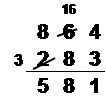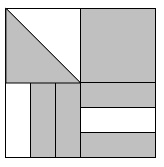Hints will display for most wrong answers; explanations for most right answers. You can attempt a question multiple times; it will only be scored correct if you get it right the first time.
I used the official objectives and sample test to construct these questions, but cannot promise that they accurately reflect what’s on the real test. Some of the sample questions were more convoluted than I could bear to write. See terms of use. See the MTEL Practice Test main page to view questions on a particular topic or to download paper practice tests.
MTEL General Curriculum Mathematics Practice
Question 1 |
In each expression below N represents a negative integer. Which expression could have a negative value?
\( \large {{N}^{2}}\) Hint: Squaring always gives a non-negative value. | |
\( \large 6-N\) Hint: A story problem for this expression is, if it was 6 degrees out at noon and N degrees out at sunrise, by how many degrees did the temperature rise by noon? Since N is negative, the answer to this question has to be positive, and more than 6. | |
\( \large -N\) Hint: If N is negative, then -N is positive | |
\( \large 6+N\) Hint: For example, if \(N=-10\), then \(6+N = -4\) |
Question 2 |
In which table below is y a function of x?
 Hint: If x=3, y can have two different values, so it's not a function. | |
 Hint: If x=3, y can have two different values, so it's not a function. | |
 Hint: If x=1, y can have different values, so it's not a function. | |
 Hint: Each value of x always corresponds to the same value of y. |
Question 3 |
If x is an integer, which of the following must also be an integer?
\( \large \dfrac{x}{2}\) Hint: If x is odd, then \( \dfrac{x}{2} \) is not an integer, e.g. 3/2 = 1.5. | |
\( \large \dfrac{2}{x}\) Hint: Only an integer if x = -2, -1, 1, or 2. | |
\( \large-x\) Hint: -1 times any integer is still an integer. | |
\(\large\sqrt{x}\) Hint: Usually not an integer, e.g. \( \sqrt{2} \approx 1.414 \). |
Question 4 |
Which of the numbers below is the decimal equivalent of \( \dfrac{3}{8}?\)
0.38Hint: If you are just writing the numerator next to the denominator then your technique is way off, but by coincidence your answer is close; try with 2/3 and 0.23 is nowhere near correct. | |
0.125Hint: This is 1/8, not 3/8. | |
0.375 | |
0.83Hint: 3/8 is less than a half, and 0.83 is more than a half, so they can't be equal. |
Question 5 |
If two fair coins are flipped, what is the probability that one will come up heads and the other tails?
\( \large \dfrac{1}{4}\) Hint: Think of the coins as a penny and a dime, and list all possibilities. | |
\( \large \dfrac{1}{3} \) Hint: This is a very common misconception. There are three possible outcomes -- both heads, both tails, and one of each -- but they are not equally likely. Think of the coins as a penny and a dime, and list all possibilities. | |
\( \large \dfrac{1}{2}\) Hint: The possibilities are HH, HT, TH, TT, and all are equally likely. Two of the four have one of each coin, so the probability is 2/4=1/2. | |
\( \large \dfrac{3}{4}\) Hint: Think of the coins as a penny and a dime, and list all possibilities. |
Question 6 |
Use the graph below to answer the question that follows.
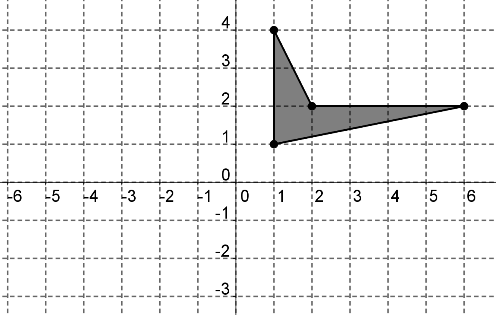
If the polygon shown above is reflected about the y axis and then rotated 90 degrees clockwise about the origin, which of the following graphs is the result?
 Hint: Try following the point (1,4) to see where it goes after each transformation. | |
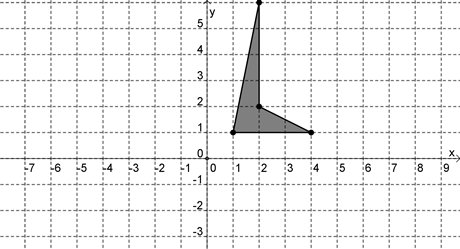 | |
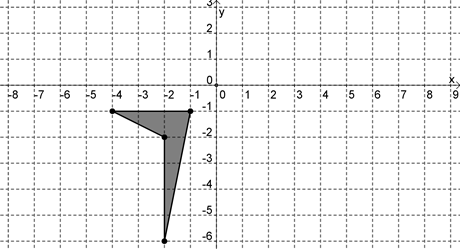
Hint: Make sure you're reflecting in the correct axis. | |
 Hint: Make sure you're rotating the correct direction. |
Question 7 |
Which of the following is not possible?
An equiangular triangle that is not equilateral.Hint: The AAA property of triangles states that all triangles with corresponding angles congruent are similar. Thus all triangles with three equal angles are similar, and are equilateral. | |
An equiangular quadrilateral that is not equilateral.Hint: A rectangle is equiangular (all angles the same measure), but if it's not a square, it's not equilateral (all sides the same length). | |
An equilateral quadrilateral that is not equiangular.Hint: This rhombus has equal sides, but it doesn't have equal angles:  | |
An equiangular hexagon that is not equilateral.Hint: This hexagon has equal angles, but it doesn't have equal sides:  |
Question 8 |
Which of the following is equal to eleven billion four hundred thousand?
\( \large 11,400,000\) Hint: That's eleven million four hundred thousand. | |
\(\large11,000,400,000\) | |
\( \large11,000,000,400,000\) Hint: That's eleven trillion four hundred thousand (although with British conventions; this answer is correct, but in the US, it isn't). | |
\( \large 11,400,000,000\) Hint: That's eleven billion four hundred million |
Question 9 |
Which of the following inequalities describes all values of x with \(\large \dfrac{x}{2}\le \dfrac{x}{3}\)?
\( \large x < 0\) Hint: If x =0, then x/2 = x/3, so this answer can't be correct. | |
\( \large x \le 0\) | |
\( \large x > 0\) Hint: If x =0, then x/2 = x/3, so this answer can't be correct. | |
\( \large x \ge 0\) Hint: Try plugging in x = 6. |
Question 10 |
Which of the numbers below is a fraction equivalent to \( 0.\bar{6}\)?
\( \large \dfrac{4}{6}\) Hint: \( 0.\bar{6}=\dfrac{2}{3}=\dfrac{4}{6}\) | |
\( \large \dfrac{3}{5}\) Hint: This is equal to 0.6, without the repeating decimal. Answer is equivalent to choice c, which is another way to tell that it's wrong. | |
\( \large \dfrac{6}{10}\) Hint: This is equal to 0.6, without the repeating decimal. Answer is equivalent to choice b, which is another way to tell that it's wrong. | |
\( \large \dfrac{1}{6}\) Hint: This is less than a half, and \( 0.\bar{6}\) is greater than a half. |
Question 11 |
The student used a method that worked for this problem and can be generalized to any subtraction problem.Hint: Note that this algorithm is taught as the "standard" algorithm in much of Europe (it's where the term "borrowing" came from -- you borrow on top and "pay back" on the bottom). | |
The student used a method that worked for this problem and that will work for any subtraction problem that only requires one regrouping; it will not work if more regrouping is required.Hint: Try some more examples. | |
The student used a method that worked for this problem and will work for all three-digit subtraction problems, but will not work for larger problems.Hint: Try some more examples. | |
The student used a method that does not work. The student made two mistakes that cancelled each other out and was lucky to get the right answer for this problem.Hint: Remember, there are many ways to do subtraction; there is no one "right" algorithm. |
Question 12 |
A solution requires 4 ml of saline for every 7 ml of medicine. How much saline would be required for 50 ml of medicine?
\( \large 28 \dfrac{4}{7}\) ml Hint: 49 ml of medicine requires 28 ml of saline. The extra ml of saline requires 4 ml saline/ 7 ml medicine = 4/7 ml saline per 1 ml medicine. | |
\( \large 28 \dfrac{1}{4}\) ml Hint: 49 ml of medicine requires 28 ml of saline. How much saline does the extra ml require? | |
\( \large 28 \dfrac{1}{7}\) ml Hint: 49 ml of medicine requires 28 ml of saline. How much saline does the extra ml require? | |
\( \large 87.5\) ml Hint: 49 ml of medicine requires 28 ml of saline. How much saline does the extra ml require? |
Question 13 |
Four children randomly line up, single file. What is the probability that they are in height order, with the shortest child in front? All of the children are different heights.
\( \large \dfrac{1}{4}\) Hint: Try a simpler question with 3 children -- call them big, medium, and small -- and list all the ways they could line up. Then see how to extend your logic to the problem with 4 children. | |
\( \large \dfrac{1}{256}
\) Hint: Try a simpler question with 3 children -- call them big, medium, and small -- and list all the ways they could line up. Then see how to extend your logic to the problem with 4 children. | |
\( \large \dfrac{1}{16}\) Hint: Try a simpler question with 3 children -- call them big, medium, and small -- and list all the ways they could line up. Then see how to extend your logic to the problem with 4 children. | |
\( \large \dfrac{1}{24}\) Hint: The number of ways for the children to line up is \(4!=4 \times 3 \times 2 \times 1 =24\) -- there are 4 choices for who is first in line, then 3 for who is second, etc. Only one of these lines has the children in the order specified. |
Question 14 |
The window glass below has the shape of a semi-circle on top of a square, where the side of the square has length x. It was cut from one piece of glass.

What is the perimeter of the window glass?
\( \large 3x+\dfrac{\pi x}{2}\) Hint: By definition, \(\pi\) is the ratio of the circumference of a circle to its diameter; thus the circumference is \(\pi d\). Since we have a semi-circle, its perimeter is \( \dfrac{1}{2} \pi x\). Only 3 sides of the square contribute to the perimeter. | |
\( \large 3x+2\pi x\) Hint: Make sure you know how to find the circumference of a circle. | |
\( \large 3x+\pi x\) Hint: Remember it's a semi-circle, not a circle. | |
\( \large 4x+2\pi x\) Hint: Only 3 sides of the square contribute to the perimeter. |
Question 15 |
In January 2011, the national debt was about 14 trillion dollars and the US population was about 300 million people. Someone reading these figures estimated that the national debt was about $5,000 per person. Which of these statements best describes the reasonableness of this estimate?
It is too low by a factor of 10Hint: 14 trillion \( \approx 15 \times {{10}^{12}} \) and 300 million \( \approx 3 \times {{10}^{8}}\), so the true answer is about \( 5 \times {{10}^{4}} \) or $50,000. | |
It is too low by a factor of 100 | |
It is too high by a factor of 10 | |
It is too high by a factor of 100 |
Question 16 |
What is the length of side \(\overline{BD}\) in the triangle below, where \(\angle DBA\) is a right angle?

\( \large 1\) Hint: Use the Pythagorean Theorem. | |
\( \large \sqrt{5}\) Hint: \(2^2+e^2=3^2\) or \(4+e^2=9;e^2=5; e=\sqrt{5}\). | |
\( \large \sqrt{13}\) Hint: e is not the hypotenuse. | |
\( \large 5\) Hint: Use the Pythagorean Theorem. |
Question 17 |
Use the expression below to answer the question that follows.
\( \large 3\times {{10}^{4}}+2.2\times {{10}^{2}}\)
Which of the following is closest to the expression above?
Five millionHint: Pay attention to the exponents. Adding 3 and 2 doesn't work because they have different place values. | |
Fifty thousandHint: Pay attention to the exponents. Adding 3 and 2 doesn't work because they have different place values. | |
Three millionHint: Don't add the exponents. | |
Thirty thousandHint: \( 3\times {{10}^{4}} = 30,000;\) the other term is much smaller and doesn't change the estimate. |
Question 18 |
The prime factorization of n can be written as n=pqr, where p, q, and r are distinct prime numbers. How many factors does n have, including 1 and itself?
\( \large3\) Hint: 1, p, q, r, and pqr are already 5, so this isn't enough. You might try plugging in p=2, q=3, and r=5 to help with this problem. | |
\( \large5\) Hint: Don't forget pq, etc. You might try plugging in p=2, q=3, and r=5 to help with this problem. | |
\( \large6\) Hint: You might try plugging in p=2, q=3, and r=5 to help with this problem. | |
\( \large8\) Hint: 1, p, q, r, pq, pr, qr, pqr. |
Question 19 |
The pattern below consists of a row of black squares surrounded by white squares.

How many white squares would surround a row of 157 black squares?
314Hint: Try your procedure on a smaller number that you can count to see where you made a mistake. | |
317Hint: Are there ever an odd number of white squares? | |
320Hint: One way to see this is that there are 6 tiles on the left and right ends, and the rest of the white tiles are twice the number of black tiles (there are many other ways to look at it too). | |
322Hint: Try your procedure on a smaller number that you can count to see where you made a mistake. |
Question 20 |
Kendra is trying to decide which fraction is greater, \( \dfrac{4}{7}\) or \( \dfrac{5}{8}\). Which of the following answers shows the best reasoning?
\( \dfrac{4}{7}\) is \( \dfrac{3}{7}\)away from 1, and \( \dfrac{5}{8}\) is \( \dfrac{3}{8}\)away from 1. Since eighth‘s are smaller than seventh‘s, \( \dfrac{5}{8}\) is closer to 1, and is the greater of the two fractions. | |
\( 7-4=3\) and \( 8-5=3\), so the fractions are equal.Hint: Not how to compare fractions. By this logic, 1/2 and 3/4 are equal, but 1/2 and 2/4 are not. | |
\( 4\times 8=32\) and \( 7\times 5=35\). Since \( 32<35\) , \( \dfrac{5}{8}<\dfrac{4}{7}\)Hint: Starts out as something that works, but the conclusion is wrong. 4/7 = 32/56 and 5/8 = 35/56. The cross multiplication gives the numerators, and 35/56 is bigger. | |
\( 4<5\) and \( 7<8\), so \( \dfrac{4}{7}<\dfrac{5}{8}\)Hint: Conclusion is correct, logic is wrong. With this reasoning, 1/2 would be less than 2/100,000. |
Question 21 |
The following story situations model \( 12\div 3\):
I) Jack has 12 cookies, which he wants to share equally between himself and two friends. How many cookies does each person get?
II) Trent has 12 cookies, which he wants to put into bags of 3 cookies each. How many bags can he make?
III) Cicely has $12. Cookies cost $3 each. How many cookies can she buy?
Which of these questions illustrate the same model of division, either partitive (partioning) or measurement (quotative)?
I and II | |
I and III | |
II and IIIHint: Problem I is partitive (or partitioning or sharing) -- we put 12 objects into 3 groups. Problems II and III are quotative (or measurement) -- we put 12 objects in groups of 3. | |
All three problems model the same meaning of division |
Question 22 |
Which of the lines depicted below is a graph of \( \large y=2x-5\)?

aHint: The slope of line a is negative. | |
bHint: Wrong slope and wrong intercept. | |
cHint: The intercept of line c is positive. | |
dHint: Slope is 2 -- for every increase of 1 in x, y increases by 2. Intercept is -5 -- the point (0,-5) is on the line. |
Question 23 |
Here are some statements:
I) 5 is an integer II)\( -5 \) is an integer III) \(0\) is an integer
Which of the statements are true?
I only | |
I and II only | |
I and III only | |
I, II, and IIIHint: The integers are ...-3, -2, -1, 0, 1, 2, 3, .... |
Question 24 |
The expression \( \large{{8}^{3}}\cdot {{2}^{-10}}\) is equal to which of the following?
\( \large 2\) Hint: Write \(8^3\) as a power of 2. | |
\( \large \dfrac{1}{2}\) Hint: \(8^3 \cdot {2}^{-10}={(2^3)}^3 \cdot {2}^{-10}\) =\(2^9 \cdot {2}^{-10} =2^{-1}\) | |
\( \large 16\) Hint: Write \(8^3\) as a power of 2. | |
\( \large \dfrac{1}{16}\) Hint: Write \(8^3\) as a power of 2. |
Question 25 |
\( \large \dfrac{17}{24}\) Hint: You might try adding segments so each quadrant is divided into 6 pieces with equal area -- there will be 24 regions, not all the same shape, but all the same area, with 17 of them shaded (for the top left quarter, you could also first change the diagonal line to a horizontal or vertical line that divides the square in two equal pieces and shade one) . | |
\( \large \dfrac{3}{4}\) Hint: Be sure you're taking into account the different sizes of the pieces. | |
\( \large \dfrac{2}{3}\) Hint: The bottom half of the picture is 2/3 shaded, and the top half is more than 2/3 shaded, so this answer is too small. | |
\( \large \dfrac{17}{6} \) Hint: This answer is bigger than 1, so doesn't make any sense. Be sure you are using the whole picture, not one quadrant, as the unit. |
Question 26 |
The equation \( \large F=\frac{9}{5}C+32\) is used to convert a temperature measured in Celsius to the equivalent Farentheit temperature.
A patient's temperature increased by 1.5° Celcius. By how many degrees Fahrenheit did her temperature increase?
1.5°Hint: Celsius and Fahrenheit don't increase at the same rate. | |
1.8°Hint: That's how much the Fahrenheit temp increases when the Celsius temp goes up by 1 degree. | |
2.7°Hint: Each degree increase in Celsius corresponds to a \(\dfrac{9}{5}=1.8\) degree increase in Fahrenheit. Thus the increase is 1.8+0.9=2.7. | |
Not enough information.Hint: A linear equation has constant slope, which means that every increase of the same amount in one variable, gives a constant increase in the other variable. It doesn't matter what temperature the patient started out at. |
Question 27 |
A family went on a long car trip. Below is a graph of how far they had driven at each hour.

Which of the following is closest to their average speed driving on the trip?
\( \large d=20t\) Hint: Try plugging t=7 into the equation, and see how it matches the graph. | |
\( \large d=30t\) Hint: Try plugging t=7 into the equation, and see how it matches the graph. | |
\( \large d=40t\) | |
\( \large d=50t\) Hint: Try plugging t=7 into the equation, and see how it matches the graph. |
Question 28 |
Use the graph below to answer the question that follows:
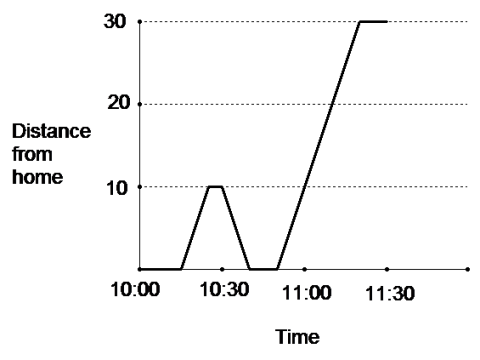
The graph above best matches which of the following scenarios:
George left home at 10:00 and drove to work on a crooked path. He was stopped in traffic at 10:30 and 10:45. He drove 30 miles total.Hint: Just because he ended up 30 miles from home doesn't mean he drove 30 miles total. | |
George drove to work. On the way to work there is a little hill and a big hill. He slowed down for them. He made it to work at 11:15.Hint: The graph is not a picture of the roads. | |
George left home at 10:15. He drove 10 miles, then realized he‘d forgotten something at home. He turned back and got what he‘d forgotten. Then he drove in a straight line, at many different speeds, until he got to work around 11:15.Hint: A straight line on a distance versus time graph means constant speed. | |
George left home at 10:15. He drove 10 miles, then realized he‘d forgotten something at home. He turned back and got what he‘d forgotten. Then he drove at a constant speed until he got to work around 11:15. |
Question 29 |
Which of the following values of x satisfies the inequality \( \large \left| {{(x+2)}^{3}} \right|<3?\)
\( \large x=-3\) Hint: \( \left| {{(-3+2)}^{3}} \right|\)=\( \left | {(-1)}^3 \right | \)=\( \left | -1 \right |=1 \) . | |
\( \large x=0\) Hint: \( \left| {{(0+2)}^{3}} \right|\)=\( \left | {2}^3 \right | \)=\( \left | 8 \right | \) =\( 8\) | |
\( \large x=-4\) Hint: \( \left| {{(-4+2)}^{3}} \right|\)=\( \left | {(-2)}^3 \right | \)=\( \left | -8 \right | \) =\( 8\) | |
\( \large x=1\) Hint: \( \left| {{(1+2)}^{3}} \right|\)=\( \left | {3}^3 \right | \)=\( \left | 27 \right | \) = \(27\) |
Question 30 |
A teacher has a list of all the countries in the world and their populations in March 2012. She is going to have her students use technology to compute the mean and median of the numbers on the list. Which of the following statements is true?
The teacher can be sure that the mean and median will be the same without doing any computation.Hint: Does this make sense? How likely is it that the mean and median of any large data set will be the same? | |
The teacher can be sure that the mean is bigger than the median without doing any computation.Hint: This is a skewed distribution, and very large countries like China and India contribute huge numbers to the mean, but are counted the same as small countries like Luxembourg in the median (the same thing happens w/data on salaries, where a few very high income people tilt the mean -- that's why such data is usually reported as medians). | |
The teacher can be sure that the median is bigger than the mean without doing any computation.Hint: Think about a set of numbers like 1, 2, 3, 4, 10,000 -- how do the mean/median compare? How might that relate to countries of the world? | |
There is no way for the teacher to know the relative size of the mean and median without computing them.Hint: Knowing the shape of the distribution of populations does give us enough info to know the relative size of the mean and median, even without computing them. |
Question 31 |
In March of 2012, 1 dollar was worth the same as 0.761 Euros, and 1 dollar was also worth the same as 83.03 Japanese Yen. Which of the expressions below gives the number of Yen that are worth 1 Euro?
\( \large {83}.0{3}\cdot 0.{761}\) Hint: This equation gives less than the number of yen per dollar, but 1 Euro is worth more than 1 dollar. | |
\( \large \dfrac{0.{761}}{{83}.0{3}}\) Hint: Number is way too small. | |
\( \large \dfrac{{83}.0{3}}{0.{761}}\) Hint: One strategy here is to use easier numbers, say 1 dollar = .5 Euros and 100 yen, then 1 Euro would be 200 Yen (change the numbers in the equations and see what works). Another is to use dimensional analysis: we want # yen per Euro, or yen/Euro = yen/dollar \(\times\) dollar/Euro = \(83.03 \times \dfrac {1}{0.761}\) | |
\( \large \dfrac{1}{0.{761}}\cdot \dfrac{1}{{83}.0{3}}\) Hint: Number is way too small. |
Question 32 |
Use the table below to answer the question that follows:
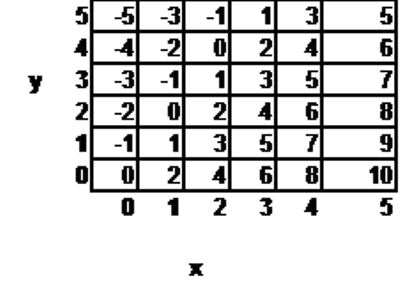
Each number in the table above represents a value W that is determined by the values of x and y. For example, when x=3 and y=1, W=5. What is the value of W when x=9 and y=14? Assume that the patterns in the table continue as shown.
\( \large W=-5\) Hint: When y is even, W is even. | |
\( \large W=4\) Hint: Note that when x increases by 1, W increases by 2, and when y increases by 1, W decreases by 1. At x=y=0, W=0, so at x=9, y=14, W has increased by \(9 \times 2\) and decreased by 14, or W=18-14=4. | |
\( \large W=6\) Hint: Try fixing x or y at 0, and start by finding W for x=0 y=14 or x=9, y=0. | |
\( \large W=32\) Hint: Try fixing x or y at 0, and start by finding W for x=0 y=14 or x=9, y=0. |
Question 33 |
Taxicab fares in Boston (Spring 2012) are $2.60 for the first \(\dfrac{1}{7}\) of a mile or less and $0.40 for each \(\dfrac{1}{7}\) of a mile after that.
Let d represent the distance a passenger travels in miles (with \(d>\dfrac{1}{7}\)). Which of the following expressions represents the total fare?
\( \large \$2.60+\$0.40d\) Hint: It's 40 cents for 1/7 of a mile, not per mile. | |
\( \large \$2.60+\$0.40\dfrac{d}{7}\) Hint: According to this equation, going 7 miles would cost $3; does that make sense? | |
\( \large \$2.20+\$2.80d\) Hint: You can think of the fare as $2.20 to enter the cab, and then $0.40 for each 1/7 of a mile, including the first 1/7 of a mile (or $2.80 per mile).
Alternatively, you pay $2.60 for the first 1/7 of a mile, and then $2.80 per mile for d-1/7 miles. The total is 2.60+2.80(d-1/7) = 2.60+ 2.80d -.40 = 2.20+2.80d. | |
\( \large \$2.60+\$2.80d\) Hint: Don't count the first 1/7 of a mile twice. |
Question 34 |
A class is using base-ten block to represent numbers. A large cube represents 1000, a flat represents 100, a rod represents 10, and a little cube represents 1. Which of these is not a correct representation for 2,347?
23 flats, 4 rods, 7 little cubesHint: Be sure you read the question carefully: 2300+40+7=2347 | |
2 large cubes, 3 flats, 47 rodsHint: 2000+300+470 \( \neq\) 2347 | |
2 large cubes, 34 rods, 7 little cubesHint: Be sure you read the question carefully: 2000+340+7=2347 | |
2 large cubes, 3 flats, 4 rods, 7 little cubesHint: Be sure you read the question carefully: 2000+300+40+7=2347 |
Question 35 |
A family has four children. What is the probability that two children are girls and two are boys? Assume the the probability of having a boy (or a girl) is 50%.
\( \large \dfrac{1}{2}\) Hint: How many different configurations are there from oldest to youngest, e.g. BGGG? How many of them have 2 boys and 2 girls? | |
\( \large \dfrac{1}{4}\) Hint: How many different configurations are there from oldest to youngest, e.g. BGGG? How many of them have 2 boys and 2 girls? | |
\( \large \dfrac{1}{5}\) Hint: Some configurations are more probable than others -- i.e. it's more likely to have two boys and two girls than all boys. Be sure you are weighting properly. | |
\( \large \dfrac{3}{8}\) Hint: There are two possibilities for each child, so there are \(2 \times 2 \times 2 \times 2 =16\) different configurations, e.g. from oldest to youngest BBBG, BGGB, GBBB, etc. Of these configurations, there are 6 with two boys and two girls (this is the combination \(_{4}C_{2}\) or "4 choose 2"): BBGG, BGBG, BGGB, GGBB, GBGB, and GBBG. Thus the probability is 6/16=3/8. |
Question 36 |
Use the expression below to answer the question that follows:
\( \large \dfrac{\left( 7,154 \right)\times \left( 896 \right)}{216}\)
Which of the following is the best estimate of the expression above?
2,000Hint: The answer is bigger than 7,000. | |
20,000Hint: Estimate 896/216 first. | |
3,000Hint: The answer is bigger than 7,000. | |
30,000Hint: \( \dfrac{896}{216} \approx 4\) and \(7154 \times 4\) is over 28,000, so this answer is closest. |
Question 37 |
The table below gives the result of a survey at a college, asking students whether they were residents or commuters:
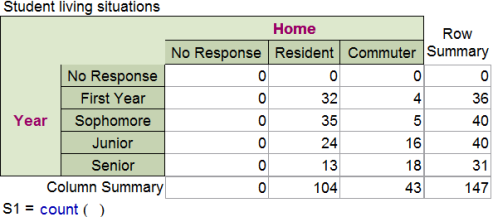
Based on the above data, what is the probability that a randomly chosen commuter student is a junior or a senior?
\( \large \dfrac{34}{43}\) | |
\( \large \dfrac{34}{71}\) Hint: This is the probability that a randomly chosen junior or senior is a commuter student. | |
\( \large \dfrac{34}{147}\) Hint: This is the probability that a randomly chosen student is a junior or senior who is a commuter. | |
\( \large \dfrac{71}{147}\) Hint: This is the probability that a randomly chosen student is a junior or a senior. |
Question 38 |
The chairs in a large room can be arranged in rows of 18, 25, or 60 with no chairs left over. If C is the smallest possible number of chairs in the room, which of the following inequalities does C satisfy?
\( \large C\le 300\) Hint: Find the LCM. | |
\( \large 300 < C \le 500 \) Hint: Find the LCM. | |
\( \large 500 < C \le 700 \) Hint: Find the LCM. | |
\( \large C>700\) Hint: The LCM is 900, which is the smallest number of chairs. |
Question 39 |
Which of the following sets of polygons can be assembled to form a pentagonal pyramid?
2 pentagons and 5 rectangles.Hint: These can be assembled to form a pentagonal prism, not a pentagonal pyramid. | |
1 square and 5 equilateral triangles.Hint: You need a pentagon for a pentagonal pyramid. | |
1 pentagon and 5 isosceles triangles. | |
1 pentagon and 10 isosceles triangles. |
Question 40 |
How many lines of reflective symmetry and how many centers of rotational symmetry does the parallelogram depicted below have?

4 lines of reflective symmetry, 1 center of rotational symmetry.Hint: Try cutting out a shape like this one from paper, and fold where you think the lines of reflective symmetry are (or put a mirror there). Do things line up as you thought they would? | |
2 lines of reflective symmetry, 1 center of rotational symmetry.Hint: Try cutting out a shape like this one from paper, and fold where you think the lines of reflective symmetry are (or put a mirror there). Do things line up as you thought they would? | |
0 lines of reflective symmetry, 1 center of rotational symmetry.Hint: The intersection of the diagonals is a center of rotational symmetry. There are no lines of reflective symmetry, although many people get confused about this fact (best to play with hands on examples to get a feel). Just fyi, the letter S also has rotational, but not reflective symmetry, and it's one that kids often write backwards. | |
2 lines of reflective symmetry, 0 centers of rotational symmetry.Hint: Try cutting out a shape like this one from paper. Trace onto another sheet of paper. See if there's a way to rotate the cut out shape (less than a complete turn) so that it fits within the outlines again. |
Question 41 |
There are 15 students for every teacher. Let t represent the number of teachers and let s represent the number of students. Which of the following equations is correct?
\( \large t=s+15\) Hint: When there are 2 teachers, how many students should there be? Do those values satisfy this equation? | |
\( \large s=t+15\) Hint: When there are 2 teachers, how many students should there be? Do those values satisfy this equation? | |
\( \large t=15s\) Hint: This is a really easy mistake to make, which comes from transcribing directly from English, "1 teachers equals 15 students." To see that it's wrong, plug in s=2; do you really need 30 teachers for 2 students? To avoid this mistake, insert the word "number," "Number of teachers equals 15 times number of students" is more clearly problematic. | |
\( \large s=15t\) |
Question 42 |
Use the expression below to answer the question that follows.
\( \large \dfrac{\left( 4\times {{10}^{3}} \right)\times \left( 3\times {{10}^{4}} \right)}{6\times {{10}^{6}}}\)
Which of the following is equivalent to the expression above?
2Hint: \(10^3 \times 10^4=10^7\), and note that if you're guessing when the answers are so closely related, you're generally better off guessing one of the middle numbers. | |
20Hint: \( \dfrac{\left( 4\times {{10}^{3}} \right)\times \left( 3\times {{10}^{4}} \right)}{6\times {{10}^{6}}}=\dfrac {12 \times {{10}^{7}}}{6\times {{10}^{6}}}=\)\(2 \times {{10}^{1}}=20 \) | |
200Hint: \(10^3 \times 10^4=10^7\) | |
2000Hint: \(10^3 \times 10^4=10^7\), and note that if you're guessing when the answers are so closely related, you're generally better off guessing one of the middle numbers. |
Question 43 |
Below is a portion of a number line:

Point B is halfway between two tick marks. What number is represented by Point B?
\( \large 0.645\) Hint: That point is marked on the line, to the right. | |
\( \large 0.6421\) Hint: That point is to the left of point B. | |
\( \large 0.6422\) Hint: That point is to the left of point B. | |
\( \large 0.6425\) |
Question 44 |
A family on vacation drove the first 200 miles in 4 hours and the second 200 miles in 5 hours. Which expression below gives their average speed for the entire trip?
\( \large \dfrac{200+200}{4+5}\) Hint: Average speed is total distance divided by total time. | |
\( \large \left( \dfrac{200}{4}+\dfrac{200}{5} \right)\div 2\) Hint: This seems logical, but the problem is that it weights the first 4 hours and the second 5 hours equally, when each hour should get the same weight in computing the average speed. | |
\( \large \dfrac{200}{4}+\dfrac{200}{5} \) Hint: This would be an average of 90 miles per hour! | |
\( \large \dfrac{400}{4}+\dfrac{400}{5} \) Hint: This would be an average of 180 miles per hour! Even a family of race car drivers probably doesn't have that average speed on a vacation! |
Question 45 |
The Venn Diagram below gives data on the number of seniors, athletes, and vegetarians in the student body at a college:

How many students at the college are seniors who are not vegetarians?
\( \large 137\) Hint: Doesn't include the senior athletes who are not vegetarians. | |
\( \large 167\) | |
\( \large 197\) Hint: That's all seniors, including vegetarians. | |
\( \large 279\) Hint: Includes all athletes who are not vegetarians, some of whom are not seniors. |
|
List |
If you found a mistake or have comments on a particular question, please contact me (please copy and paste at least part of the question into the form, as the numbers change depending on how quizzes are displayed). General comments can be left here.
